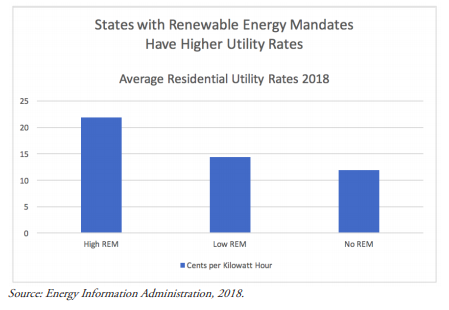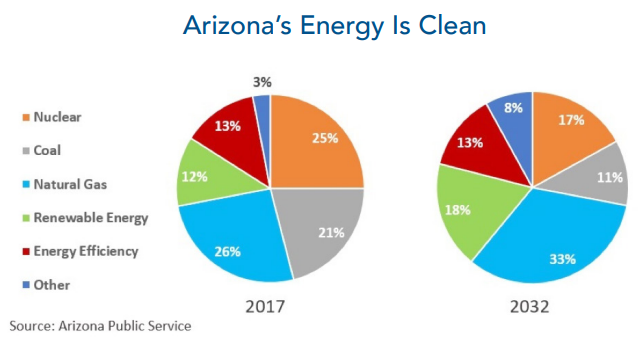Five Facts about Arizona Prop 127 and Its Effects on Energy Costs and the Environment
October 17, 2018
Most people would say they want cleaner, more affordable energy. But is Proposition 127—appearing on the Arizona statewide ballot this November—the way to get there?
As economist Stephen Moore explains in a brand-new Goldwater Institute study, Arizona’s already on the path to a clean energy future—and Prop 127 would raise costs on families and businesses without bringing that future any closer. In Defense of Liberty rounds up the details:
- What would Prop 127 do?
Proposition 127 will ask Arizona voters if the state constitution should be amended to require that utilities and electric cooperatives generate at least 50 percent of their annual sales of electricity from renewable energy sources by 2030—that’s up from 15 percent today. Supporters of the initiative say it will result in lower costs, cleaner air, and more jobs for Arizona.
But that’s just not true. On the contrary, Prop 127 would raise energy costs for Arizona consumers and make almost no impact on air quality or greenhouse gas emissions.
- States that have enacted strict renewable energy mandates have been plagued by higher energy costs with little to no environmental impact.
As Arizonans consider Prop 127, they have a lot of evidence to look at for how it might work in practice. Several states have enacted renewable energy mandates (REMs) similar to the one in Prop 127—and it’s clear that states with high REMs (requiring 50 percent renewable energy or more) are paying higher utility rates than those with low or no REMs:

First, look at California: The Golden State moved to a 50 percent renewable energy mandate in 2015, and it now charges residents roughly 20 cents per kilowatt hour. That’s the fifth-highest rate in the country (only Hawaii, Alaska, Connecticut, and Massachusetts pay more). By contrast, Arizonans currently pay just a little more than the national average, which is 13.1 cents per kilowatt hour, according to the U.S. Energy Information Administration. This means if Arizona’s energy bills rose to the level of California’s, Arizonans would pay almost 50 percent more each month in utility bills.
Then take a look at Florida: Florida doesn’t have a clean energy mandate, and it uses natural gas, solar energy, clean coal, and nuclear power. Its utility costs have fallen by 3 percent since 2011. So the evidence from other states paints a very clear picture: Energy mandates drive up electric power costs—and Arizonans ought to keep that in mind.
- The negative repercussions of Prop 127 would hurt lower-income families the most.
Arizona’s so-called “clean energy” initiative is really more about cleaning out the wallets of lower-income Arizonans. Low-income households typically pay four to five times more of their income in energy costs than do wealthy families, while middle-class families pay at least twice as high a share of their income in energy bills than do the rich. Prop 127 could cost middle- and lower-income Arizona families about $1,000 more per year in utility prices.
So Prop 127 is really a regressive tax imposed on those who can least afford it. As Moore writes in his study, energy mandates like Prop 127 “are a 21st century reversal of Robin Hood: stealing from the poor to subsidize the rich.”
- Prop 127 crowds out two of the cleanest forms of energy production.
Prop 127 requires the vast majority of its green energy to come from wind and solar. But two of the cleanest energy forms—nuclear energy and natural gas—are excluded from the initiative.
Nuclear power puts out virtually zero emissions into the atmosphere, effectively and affordably reducing ozone, lead, carbon monoxide, and smog. Additionally, Arizona is home to the Palo Verde plant, one of the most cost-effective nuclear plants in operation and a supplier of many jobs.
And increased domestic production of natural gas has been a major driver of the reduction of the United States’ carbon and greenhouse gas emissions over the past ten years. Its cost has also fallen significantly—from $10 to $3 per million cubic feet in that time period—so there’s really no way to justify from either an environmental or a cost perspective.
- Arizona already gets half of its energy from green sources.
Prop 127 would require 50 percent of Arizona’s electricity to come from specific renewable sources, namely wind and solar. But nuclear energy and natural gas already make up about half of the state’s energy—see the chart below. So Prop 127 won’t have the effect of improving air quality or cutting greenhouse gas emissions in Arizona.

As Moore writes, “the major effect of Prop 127 would be to require Arizona utilities to use less nuclear and natural gas and more wind and solar—even though nuclear and natural gas are expected to continue to be much cheaper to produce.” And the cut in nuclear and natural gas will mean a loss of jobs in those areas, even though Prop 127 supporters say it will create thousands of jobs.
You can read Moore’s full study here to learn more about the negative impacts Prop 127 would have on Arizona households and businesses should the initiative pass this November.
Get Connected to Goldwater
Sign up for the latest news, event updates, and more.
Recommended Blogs

Donate Now
Help all Americans live freer, happier lives. Join the Goldwater Institute as we defend and strengthen freedom in all 50 states.
Donate NowSince 1988, the Goldwater Institute has been in the liberty business — defending and promoting freedom, and achieving more than 400 victories in all 50 states. Donate today to help support our mission.

We Protect Your Rights
Our attorneys defend individual rights and protect those who cannot protect themselves.
Need Help? Submit a case.


